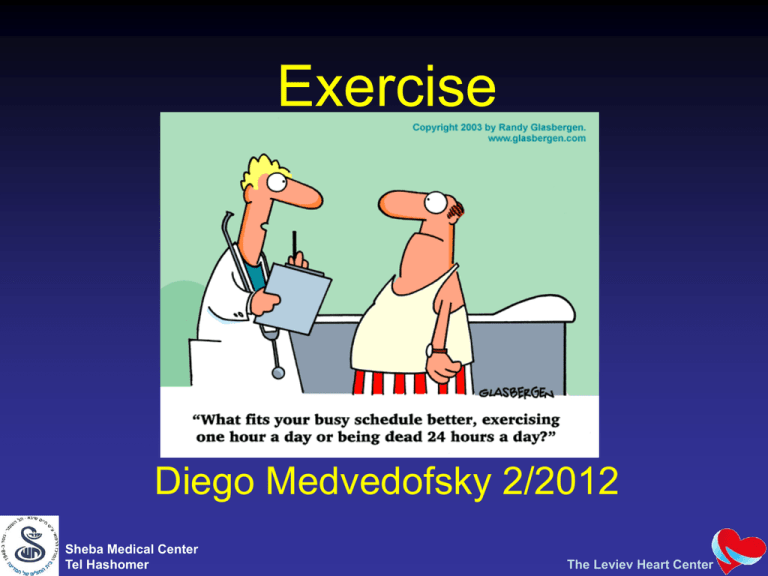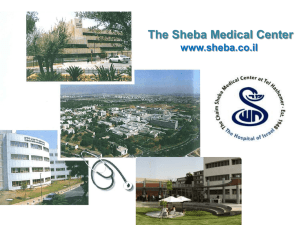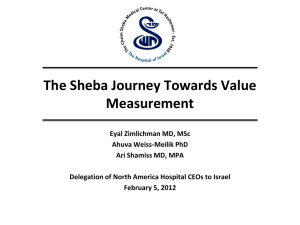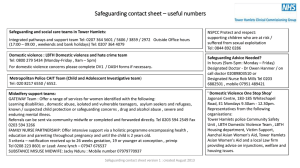Slide 1 - his
advertisement

Exercise Diego Medvedofsky 2/2012 Sheba Medical Center Tel Hashomer The Leviev Heart Center Sheba Medical Center Tel Hashomer The Leviev Heart Center Background • ~50% of pts with symptomatic HF experience HFpEF • Morbi-mortality is high and comparable to HF with reduced LVEF (HFrEF) • In HFpEF no effective therapeutic strategies shown to be effective in large clinical trials Sheba Medical Center Tel Hashomer The Leviev Heart Center Background • In HFrEF exercise training (ET) improves exercise capacity and reduces morbidity (Van Tol, Eur J Heart Fail 2006) • HF-ACTION also demonstrated a benefit with ET in HFrEF (Piepoli, BMJ 2004, O’Connor, JAMA 2009) • Conditions associated with HFpEF (endothelial dysfunction, systemic inflammation, metabolic sme) are improved by ET (Adamopoulos, Eur Heart J 2001, Boulé, JAMA 2001, Linke, JACC 2001) Sheba Medical Center Tel Hashomer The Leviev Heart Center Objectives To determine whether structured exercise training (ET) improves – Exercise performnce – LV diastolic FC – Quality of life (QoL) in pts with HF with preserved ejection fraction (HFpEF) Sheba Medical Center Tel Hashomer The Leviev Heart Center Methods • Prospective, multicenter, blind, RCT in HFpEF • • • • NYHA II/III LVEF≥50% Sinus At least 1 of: overweight, DM, HTN, hyperlipidemia, smoking Sheba Medical Center Tel Hashomer The Leviev Heart Center Methods: Exclusion criteria • Significant valvular disorders, pulmonary disease, angina, untreated CAD>50%, S/P MI, anemia, BP>150/100 mmHg, relevant arrhythmia, change in CV cardiovascular medication in previous 4 weeks Sheba Medical Center Tel Hashomer The Leviev Heart Center Sheba Medical Center Tel Hashomer The Leviev Heart Center Methods • 64 pts (age 65±7, 56% female) with HFpEF were prospectively randomized (2:1) to – From 1/2007-8/2007 – Supervised endurance/resistance training in addition to usual care (ET, n=44) – Usual care alone (UC) (n=20) Sheba Medical Center Tel Hashomer The Leviev Heart Center Sheba Medical Center Tel Hashomer The Leviev Heart Center Sheba Medical Center Tel Hashomer The Leviev Heart Center Intervention • Supervised, facility based training program • Endurance and resistance (32 sessions) • Weeks 1-4: aerobic endurance (cycling) – Target HR of 50-60% of peak oxygen uptake (peak VO2) baseline Sheba Medical Center Tel Hashomer The Leviev Heart Center Intervention • From week 5: – ↑ training freq and workload – Added resistance training (bench press, leg press, leg curl, rowing machine, triceps dip, latissimus pull down) Sheba Medical Center Tel Hashomer The Leviev Heart Center Methods • Primary endpoint – Change in peak VO2 after 3 months Sheba Medical Center Tel Hashomer The Leviev Heart Center Methods • Secondary endpoints – Systolic and diastolic function – Effects on cardiac structure [LV mass index (LVMI) and LA volume index (LAVI)] – QoL [Health Survey (SF-36) and Minnesota Questionnaire (MLWHFQ)] – Serum biomarkers: • NT-proBNP • PINP (serum procollagen type I-NP) Sheba Medical Center Tel Hashomer The Leviev Heart Center Sheba Medical Center Tel Hashomer The Leviev Heart Center Sheba Medical Center Tel Hashomer The Leviev Heart Center Results • Peak VO2 – The mean benefit of ET was 3.3 ml/min/kg (95% CI: 1.8 to 4.8, p<0.001), NNT 3.5 – Increase in 6 min walk of 24 m (<0.001) Sheba Medical Center Tel Hashomer The Leviev Heart Center Sheba Medical Center Tel Hashomer The Leviev Heart Center Sheba Medical Center Tel Hashomer The Leviev Heart Center Results • E/e' and LA volume index – ↓ with ET, unchanged with UC • The physical functioning score (36-Item Short-Form Health Survey) – ↑ with ET, unchanged with UC Sheba Medical Center Tel Hashomer The Leviev Heart Center Safety • Brief episodes of palpitations (2) • Dyspnea (3) • Mild musculoskeletal discomfort (9) Sheba Medical Center Tel Hashomer The Leviev Heart Center Compliance • Training group - exercise sessions – N=15 (34%) participated in >90% – N=23 (52%) in 70% to 90% – N=6 (14%) in <70% Sheba Medical Center Tel Hashomer The Leviev Heart Center Conclusions • 1ST multicenter, prospective RCT • Effects of supervised, structured ET on HFpEF pts – exercise capacity – diastolic function (atrial reverse remodeling and improved LV diastolic function) – QoL • Endurance/resistance ET over 3 months was a feasible, safe, and effective intervention Sheba Medical Center Tel Hashomer The Leviev Heart Center Limitations • Nature of ET interventions prohibits pure blinding • Small number of younger and middle aged pts in short-term follow-up Sheba Medical Center Tel Hashomer The Leviev Heart Center Sheba Medical Center Tel Hashomer The Leviev Heart Center Background • Adults with congenital heart disease (CHD) are at increased risk of mortality and morbidity • Parameters of cardiopulmonary exercise testing (CPX) identified as strong predictors of mortality in adults with CHD – guide clinicians in assessing prognosis and planning interventions Sheba Medical Center Tel Hashomer The Leviev Heart Center Investigation • Relation between CPX parameters and their combination • may provide optimal prognostic info on midterm survival in this population Sheba Medical Center Tel Hashomer The Leviev Heart Center Methods • 1375 pts w/adult (>14y) CHD (33±13 y) – Retrospectively – CPX – Single center, 10 years (1999-2008) – All cause mortality • Measured: – Peak oxygen consumption (peak VO2) – Ventilation/CO2 (VE/VCO2 slope) – HR reserve (peak - resting HR) Sheba Medical Center Tel Hashomer The Leviev Heart Center Cardiopulmonary Exercise Testing • On a treadmill - modified Bruce protocol • All patients were encouraged to exercise to exhaustion • Respiratory mass spectrometer: ventilation, VO2, VCO2 • ECG: HR • Manually sphygmomanometry: BP • Pulse oximetry: O2 saturation Sheba Medical Center Tel Hashomer The Leviev Heart Center SO2< 90% 16% I 51% II 39% Simple: ASD VSD PDA AO coartat Sheba Medical Center Tel Hashomer The Leviev Heart Center BB, CCB, AMIODAR Sheba Medical Center Tel Hashomer The Leviev Heart Center Sheba Medical Center Tel Hashomer The Leviev Heart Center Results • Follow-up of 5.8 years – 117 patients died: • HF 41 • SCD 34 • Perioperative 12 • Inf 5 • PE 1 • Hemoptysis 1 • Brain hemorrhage 1 • Out of Hospital 21 Sheba Medical Center Tel Hashomer The Leviev Heart Center Results Sheba Medical Center Tel Hashomer The Leviev Heart Center Results • Risk of death ↑ with: – ↓ peak VO2 – ↓ HR reserve – ↑ VE/VCO2 slope in noncyanotic pts • Not predictive in cyanotic pts – Combination of peak VO2+HR reserve • greatest predictive info • ↓ in pts with peak respiratory exchange ratio <1.0 Sheba Medical Center Tel Hashomer The Leviev Heart Center Sheba Medical Center (Neg chronotropic Tel Hashomer agents) The Leviev Heart Center Sheba Medical Center Tel Hashomer The Leviev Heart Center Conclusions • Peak VO2 and HR reserve data can be used to generate estimates of 5-year survival across a wide spectrum of adults with CHD Sheba Medical Center Tel Hashomer The Leviev Heart Center Conclusions • CPX: strong prognostic info in adult pts w/CHD – Data useful for comparing the exercise capacity of a particular patient vs pts in the same diagnostic group Sheba Medical Center Tel Hashomer The Leviev Heart Center Limitations • • • • Retrospective Part of routine evaluation Tertiary center Ed: patients terminated exercise before reaching their cardiovascular limit Sheba Medical Center Tel Hashomer The Leviev Heart Center THANKS THANKS Sheba Medical Center Tel Hashomer The Leviev Heart Center





